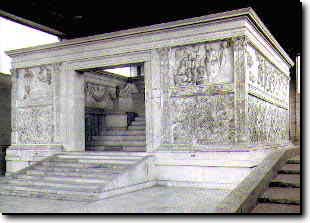-
- This religious monument was erected in 13-9 b.C. to
celebrate the peace established in the Roman empire by Augustus. Originally
it was located on the site of present Palazzo Fiano. The altar was partly
excavated beneath the palace in 1568 and in the 19th century, and its
fragments went to different collections and museums of Europe. The basement
and last pieces of Ara Pacis were extracted in 1937-1938 thanks to a new
technique of ground freezing, which permitted to excavate under a palace
without bringing any damage to it.
- The altar was recomposed of numerous pieces close to
Mausoleum of Augustus. For this aim the area was cleaned from houses.
- A big relief belonging to the monument and located
in Vatican Museums was granted by Pius XII for the reconstruction of altar.
It was surrounded by glass container and unveiled on September 23, 1938.
- The monument itself consists of marble enclosure
decorated with the finest sculptures, which covers the altar. The enclosure
is circa 10mx11m is composed of a simple base, two horizontal bands with the
leaves, on which are swans with outstretched wings, and a frieze with the
figures. Its height is 4,80 meters. The sculptured panels represent a
procession of the members of the imperial family with Augustus in the head
of it, State officials, and priests. Close to the south entrance were
represented the Magna Mater and Dea Roma with the other divinities. On the
sides of the north entrance are scenes illustrating origins of Rome
Lupercalia and Aeneas sacrificing the white sow.
- The altar is an exact reconstruction of all
recovered fragments.
|

